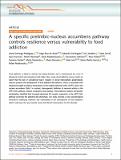Por favor, use este identificador para citar o enlazar a este item:
http://hdl.handle.net/10261/217303COMPARTIR / EXPORTAR:
 SHARE SHARE
 CORE
BASE CORE
BASE
|
|
| Visualizar otros formatos: MARC | Dublin Core | RDF | ORE | MODS | METS | DIDL | DATACITE | |

| Título: | A specific prelimbic-nucleus accumbens pathway controls resilience versus vulnerability to food addiction |
Autor: | Domingo-Rodriguez, L.; Ruiz de Azua, I.; Domínguez, Eduardo; Senabre, E.; Serra, Irene CSIC ORCID; Kummer, S.; Navandar, M.; Baddenhausen, S.; Hofmann, C.; Andero, R; Gerber, S.; Navarrete, Marta CSIC ORCID ; Dierssen, Mara CSIC; Lutz, Beat; Martín-García, Elena; Maldonado, Rafael | Fecha de publicación: | 2020 | Editor: | Nature Publishing Group | Citación: | Nature Communications 11 (2020) | Resumen: | Food addiction is linked to obesity and eating disorders and is characterized by a loss of behavioral control and compulsive food intake. Here, using a food addiction mouse model, we report that the lack of cannabinoid type-1 receptor in dorsal telencephalic glutamatergic neurons prevents the development of food addiction-like behavior, which is associated with enhanced synaptic excitatory transmission in the medial prefrontal cortex (mPFC) and in the nucleus accumbens (NAc). In contrast, chemogenetic inhibition of neuronal activity in the mPFC-NAc pathway induces compulsive food seeking. Transcriptomic analysis and genetic manipulation identified that increased dopamine D2 receptor expression in the mPFC-NAc pathway promotes the addiction-like phenotype. Our study unravels a new neurobiological mechanism underlying resilience and vulnerability to the development of food addiction, which could pave the way towards novel and efficient interventions for this disorder. | Versión del editor: | http://dx.doi.org/10.1038/s41467-020-14458-y | URI: | http://hdl.handle.net/10261/217303 | DOI: | 10.1038/s41467-020-14458-y | Identificadores: | doi: 10.1038/s41467-020-14458-y issn: 2041-1723 |
| Aparece en las colecciones: | (IC) Artículos |
Ficheros en este ítem:
| Fichero | Descripción | Tamaño | Formato | |
|---|---|---|---|---|
| s41467.pdf | 1,85 MB | Adobe PDF |  Visualizar/Abrir |
CORE Recommender
PubMed Central
Citations
33
checked on 05-abr-2024
SCOPUSTM
Citations
54
checked on 23-abr-2024
WEB OF SCIENCETM
Citations
53
checked on 24-feb-2024
Page view(s)
163
checked on 22-abr-2024
Download(s)
154
checked on 22-abr-2024

